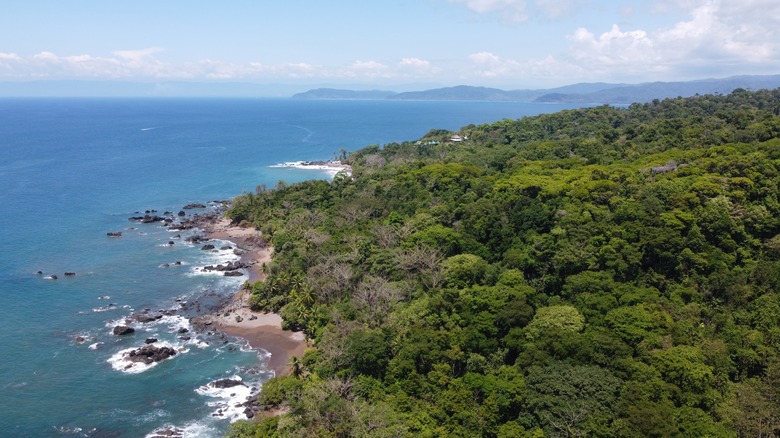This Hidden Costa Rican Coast Is One Of The World's Most Biologically Diverse Destinations
Let's take a walk on the wild side. Costa Rica is full of extraordinary places, but when it comes to wildlife, nothing compares to the Osa Peninsula. This lesser-known region sits along the Pacific Ocean's southwestern tip of Costa Rica. It is so far south that it practically grazes the edge of Panama. For animal lovers and plant enthusiasts, a trip to the Osa Peninsula is among the best things to do in Costa Rica for an unforgettable vacation. It is known as one of the most biologically diverse regions on the planet. In fact, Osa contains 2.5% of the world's biodiversity within its borders.
With close to 250,000 species residing in its 11 distinctive ecosystems, the Osa Peninsula puts the incredible natural wonders of our planet on full display. You do not want to leave your camera behind, as every destination offers unique opportunities for sightings and close encounters with some of the most astounding creatures on Earth, including jaguars, toucans, sloths, and everything in between. It is home to many conservation areas, wildlife reserves, and an often-overlooked Costa Rican national park that will take your breath away. Whether you're looking for a memorable photography excursion, a romantic adventure, or an incredible family vacation to Costa Rica, Osa Peninsula offers a thrilling and unforgettable journey into our wild world.
The incredible biodiversity of the Osa Peninsula
Costa Rica is one of the most biodiverse places in the world and is home to a staggering 500,000 species of animals. The country's wealth of flora and fauna is exemplified in the dense tropical jungles of the Osa Peninsula. This region along the southern coast is the crown jewel of Costa Rica's wildlife, with nearly half of the country's species residing in this area alone.
What makes Osa so abundant is its biological corridors and incredible stretches of natural land that give plants and animals plenty of room to thrive. Osa is also home to towering trees, over 130 feet tall, providing essential habitats for many animals. Osa has diverse ecosystems, including rainforests, coral reefs, mangrove forests, rivers and freshwater, beaches, wetlands, and more. These ecosystems are rich with resources that support all kinds of wildlife, including rare endangered species.
Visitors to the Osa Peninsula will be treated to endless animal sightings. Some of the region's most famous residents include extraordinary scarlet macaws and howler monkeys, often seen (and heard!) in their home among the treetops. It's not unlikely that you will also see brightly colored butterflies and hummingbirds, toucans, sloths, squirrel monkeys, sea turtles, and coati, cousins of the North American raccoon. If you're lucky, you may spot wildcats such as jaguars, pumas, and ocelots.
Here are the best ways to explore the Osa Peninsula
The best way to travel through the Osa Peninsula is to take a guided tour of its conservation areas, national forests, and biological reserves. Corcovado National Park is a must-visit destination. Although this adventure involves plenty of hiking in the Central American rainforest climate, you will be rewarded with many unforgettable wildlife sightings.
For marine life enthusiasts, a diving excursion to Isla del Caño Marine Biological Reserve is essential. The area is said to be one of the world's best dive sites, and the surrounding waters offer unparalleled visibility. The island has a breathtaking array of insects, birds, and amphibians. Bird watchers will be awestruck by the sights at Piedras Blancas National Park, where macaw, toucan, hawks and, hummingbirds abound. Piedras Blancas is also said to be the home of the jaguar and other wildcats, as well as otherworldly amphibians like red frogs — don't get too close, however, as these frogs are among the world's most poisonous.
The Osa Peninsula has several incredible options for accommodations that offer their own guided excursions. Encanta La Vida is a jungle beach lodge with many adventure opportunities for guests that incorporate conservation and eco-tourism, such as helping release baby sea turtles into the ocean. Lapa Rios Lodge offers beautiful luxury stays on a private nature reserve with guided waterfall hikes, educational plant tours, starfish walks, and even rainforest treks at night.


